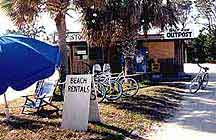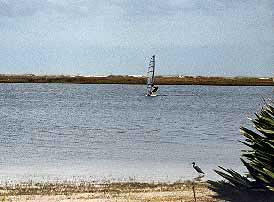|
|
ANASTASIA
STATE PARK
BEACH The park boasts a broad beach flanked by sand dunes and a lagoon bordered by rich tidal marshes. A hardwood forest of ancient wind swept oaks was in its youth when Juan Ponce de Leon landed near the area, giving Florida its name. Since Florida state parks are managed to appear (as closely as possible) as they did when the first Europeans arrived, you can easily imagine the bustle of the early native's daily life. HISTORY More than 300 years ago, sites like the coquina quarries located within Anastasia State Recreation Area were busy with workmen, mostly Native Americans, hauling out blocks of rock. By the late 1700's, the Native American population had died out and quarry workers were usually black slaves. With hand tools, they hewed out blocks of the soft shellstone and pried the squares loose along natural layers in the rock. The blocks were loaded onto ox-drawn carts, then barged across Matanzas Bay to the town of St. Augustine. The blocks were used to construct the Castillo de San Marcos and many other public and private buildings. From its founding in 1565, St. Augustine had been a struggling outpost of Spain's American empire. Spanish soldiers built their fort and their homes out of the pine trees and palmetto that were so plentiful. Time after time, their wooden settlement was destroyed by storms or burned by pirates and other European raiders. On Anastasia Island, the Spaniards discovered a better building material deposits of a rock made of broken shells. As early as 1598, they dug enough to build a gunpowder storage magazine. But they had neither the manpower, the engineering skills nor the tools to excavate enough for a large structure. Finally, in 1671 large-scale quarrying began in the stone pits. Anastasia Island was even called “Cantera,” Spanish for “quarry.” This site is one of several on the island; the St. Augustine Amphitheater is located in another site. Coquina rock is relatively soft and easy to cut while in the ground and hardens when exposed to air. The Spanish learned to waterproof the stone walls by coating them with plaster and paint. Coquina rock has a unique feature that made it ideal for a fort. When besieging ships bombarded the Castillo, the walls simply absorbed the cannon balls. Coquina continued to be a prized building material not only to the Spanish but later to the British (1763-83) and the Americans (1821). COQUINA QUARRY Coquina rock is part of a sedimentary formation that underlies much of the Atlantic shore of Florida. It is covered by sand, except along some stretches of beach in Flagler, Martin and Palm Beach counties. Washington Oaks State Gardens at Palm Coast and Blowing Rocks Preserve in Jupiter are excellent places to see coquina outcroppings. The rock is a mixture of shell fragments and quartz grains bound together by calcium carbonate. It began to form when sea levels were higher and today's coast was underwater. Sand and shells accumulated as an offshore bar. Later, during a glacial period (between 125,000-150,000 years ago), the sea level dropped, leaving the bar exposed to the air and weather. Rainwater dissolved the calcium carbonate from the shell and cemented the loose, shelly sediment into rock. The word coquina means "tiny shell" in Spanish. It was the name given to the clam (Donax variabillis) that was abundant on northeast Florida beaches. It is the predominant shell in the rock. The coquina quarries located within Anastasia State Recreation Area are protected historic sites, listed on the National Register of Historic Places; nothing can be removed from them. CAMPING Anastasia State Recreation Area has a 139 site campground that is equipped for both tent campers and RVers. Each site has a picnic table, an in-ground grill, fire ring and water. One hundred and four of the sites are equipped with electricity, if needed. None of the sites have sewer hookups, but there is a dump station located in the campground, as well as dumpsters for your household trash. For your convenience, there are two public telephones in the park; one is located in the camping area and one at the picnic area. Each of the sites is located in a shady hardwood hammock, away from the blowing sand and salt spray of the beach. However, most sites are within walking distance to the beach. There are natural barriers between each site that allow privacy for the visitor. Since one of the goals in state parks is preservation, site sizes vary. There are a few sites that can accommodate camping rigs up to 40'. A call to the Ranger Station will ensure that they can meet your particular needs. Reservations are taken for 100% of our campsites and may be made up to eleven months in advance. To reserve a campsite, call the Ranger Station at 904-461-2033 and have your Visa/MasterCard /Discover card ready to reserve your site. Please call 904-461-2033 for the current fee scheduleS. Camping supplies can be purchased at the Salt Run Outpost, located at the campground entrance. This concession-operated park store offers camping supplies, ice and firewood and has bicycles, beach and water-related equipment available for rental. DAY VISITATION  Anastasia State
Recreation Area opens at 8:00 am and closes each day at sundown. Please
call 1-800-326-3521 for the current fee schedule. The park is open year-round
for your enjoyment. Park visitors can use one of the three picnic areas
located near the beach. Each area features sheltered tables and grills.
The picnic pavilion near the beach also features restroom facilities and
soda vending machines. Anastasia State
Recreation Area opens at 8:00 am and closes each day at sundown. Please
call 1-800-326-3521 for the current fee schedule. The park is open year-round
for your enjoyment. Park visitors can use one of the three picnic areas
located near the beach. Each area features sheltered tables and grills.
The picnic pavilion near the beach also features restroom facilities and
soda vending machines.
The large beach pavilion at Anastasia is available for rental. For information on availability and cost, please call the ranger station at 904-461-2033. BEACH AND WATER RELATED ACTIVITIES  One of Anastasia State Recreation
Area's most noteworthy features is its broad beach. Driving is allowed on
the hard-packed sand north of the beach ramp. However, driving is at your
own risk and the park is not responsible for any stuck vehicles. During
sea turtle nesting season (May 1 through September 30), driving on the beach
is prohibited between sunset and sunrise. These dates may be adjusted due
to early nesting/late hatchings. One of Anastasia State Recreation
Area's most noteworthy features is its broad beach. Driving is allowed on
the hard-packed sand north of the beach ramp. However, driving is at your
own risk and the park is not responsible for any stuck vehicles. During
sea turtle nesting season (May 1 through September 30), driving on the beach
is prohibited between sunset and sunrise. These dates may be adjusted due
to early nesting/late hatchings.
Salt Run offers a place for sailboarders to enjoy the water without the restrictions of swimmers. Rental equipment and lessons are available from the concession located at Salt Run. FISHING For the fisherman, Anastasia State Recreation Area is a great place to haul in the big catch. The area just north of the bird nesting area at the jetties, as well as Salt Run, are well-used sites. While you are here, why not bring that big fish into the Ranger Station and enter our Fish of the Month Contest? The contest is sponsored by local bait and tackle shops and each month prizes are awarded to the fisherman whose catch matches the winning category. The winner is notified by mail by the middle of the following month and instructions for claiming the prize(s) are included. Fish species changes each month, so stop by the Ranger Station or call (904) 461-2033 to find out the current fish of the month. WILDLIFE Anastasia State Recreation Area has an abundance of wildlife, birds and plants, with many species of each in the park year round. As you visit, keep your eyes and ears open to the rich variety of wildlife around you, but please remember that all plant and animal life is protected in state parks. Enjoy the wonders of nature around you and help us to protect these treasures for future generations of visitors. PLANT LIFE BIRDING
SNAKES ANASTASIA STATE RECREATION AREA 1340A A1A South St. Augustine, FL 32080 |